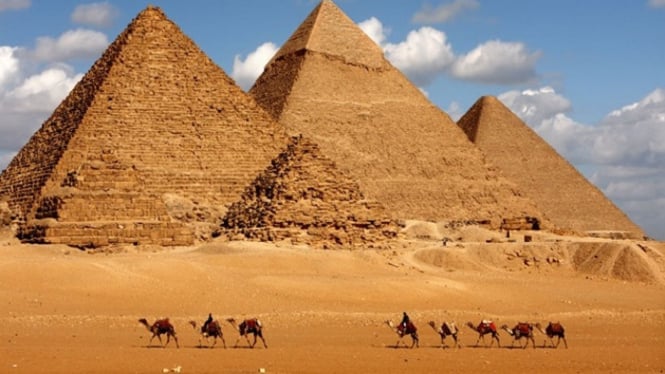- U-Report
VIVA – The Pyramids of Egypt are one of the most incredible wonders of the ancient world. Many people want to see this historical building in person. Many studies have been conducted over the centuries to explain the truth behind the construction of these gigantic structures that probably took between 15 to 30 years to complete.
Construction Timeline
Piramida Mesir.
- Pixabay
Egypt's Nile Valley was settled by 3500 BC, but the first pyramids began to appear after 2700 BC. Between 2600 and 2500 BC, the iconic Pyramids of Giza were built during the 4th Dynasty.
For reference, the 1st Dynasty lasted between 3100 BC and 2900 BC, and the oldest collection of Hieroglyphics originated from this era. A pause in pyramid construction occurred between 2300 BC and 2000 BC, but after a resurgence in popularity, the last pyramid of the Great Egyptian dynasty ended just before 1700 BC.
Construction Process
According to estimates, each pyramid took 15 to 30 years to build. The sizes vary ranging from 1.2 million to 92 million cubic feet, and since the main material is huge limestone blocks, it is understandable that some pyramids take longer than others.
The Egyptians did not make significant use of wheel-shaped mechanisms, which minimizes the theory that the stones were regularly rolled into the pyramid in a series of cylinders.
Some hieroglyphics suggest that a large group of people pulled the sled, and water was poured on the ground to reduce friction. While 30 years may seem like a long time, it would hint at a rate of one block being laid every 3 minutes, given the total of 2.3 million blocks in the Great Pyramid.
Copper tools and sand abrasion were used to cut these limestone blocks, which came from 6. 2 miles south and were transported over the Nile River by boat. Eventually, ramps wrapped around the pyramids allowed the placement of each block, and remnants of those ramps have been preserved near some of the pyramids.
Who Built the Pyramids?
Piramida Mesir.
- U-Report
Well-known modern interpretations have given the world the impression that the pyramids were built entirely by enslaved people. However, this belief is refuted by many scholars today.
Agricultural workers often built large works such as European cathedrals after the harvest and planting season ended, and similar conditions could have provided the labor needed to build the pyramids.
The regular flooding of the Nile would disrupt agricultural land use, and the solution was to provide regular work through the construction of these large tombs. Therefore, based on archaeological findings about the condition of the burial plots of these workers, it has been concluded that they were predominantly a skilled working class.
Steps in the Pyramids
The first pyramid, The Step Pyramid, was built around 2670 BC for Pharaoh Djoser. Located in the flat necropolis of Saqqara, the pyramid was designed by the famous architect Imhotep. At over 200 feet tall, this structure was probably the tallest man-made wonder at the time of its construction.
Like the tombs that followed, the purpose of this complex was to provide an adequate transition for the deceased pharaoh into the afterlife. Moreover, while the pyramid was the centerpiece of the design, elaborate burial grounds also encased the site.
One theory of design motivation was that it would be visible from the nearby city of Memphis. However, the many changes to the original blueprints throughout its construction suggest that the project may have gone through an uncertain phase. Then pyramids experienced similar problems.
Pyramids of Giza
Piramida Giza.
- Getty Images
The Pyramids of Giza and the Sphinx Statue are magnificent monuments of Ancient Egypt that attract millions of visitors to Cairo today. By 2550 BC, the Old Kingdom of Egypt was thriving. To commemorate the success, Pharaoh Khufu built a 481-foot pyramid, now known as the Great Pyramid.
Three chambers were located inside, which once housed the king's sarcophagus and his most prized possessions. Later, Pharaohs Khafre and Menkaure built pyramids for themselves, both completed in 2504 BC.
Pyramid of Khendjer
The east side of the pyramid of Khendjer's pyramid, depicts the king with Atum and Re at the Egyptian Museum in Cairo.
Many great pyramids were built for pharaohs, but the last one is considered the Pyramid of Khendjer pharaoh and is located right in Saqqara, where the first one was made. The pyramid stands 122 feet tall and is the only one completed in the 13th Dynasty.
Destructive excavations in the 1930s left the site in ruins. In retrospect, this was probably the last pyramid because of the enormous cost and organization required to build these monuments, and after a thousand years, religious reasons were not relevant enough to the changing population. However, the pyramids of Piye and Taharqa were built in 721 BC and 664 BC respectively, during a minor revival.





























